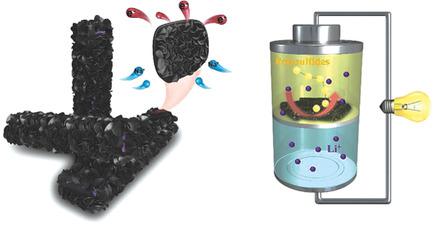当前位置:
X-MOL 学术
›
Small Methods
›
论文详情
Our official English website, www.x-mol.net, welcomes your feedback! (Note: you will need to create a separate account there.)
Rational Design of Hierarchical TiO2/Epitaxially Aligned MoS2–Carbon Coupled Interface Nanosheets Core/Shell Architecture for Ultrastable Sodium‐Ion and Lithium–Sulfur Batteries
Small Methods ( IF 12.4 ) Pub Date : 2018-07-20 , DOI: 10.1002/smtd.201800119 Yong Yang 1 , Shitong Wang 2 , Sen Lin 3 , Yutong Li 2 , Weiyu Zhang 1 , Yuguang Chao 1 , Mingchuan Luo 1 , Yi Xing 1 , Kai Wang 1 , Chao Yang 1 , Peng Zhou 1 , Yelong Zhang 1 , Zilong Tang 2 , Shaojun Guo 1, 4
Small Methods ( IF 12.4 ) Pub Date : 2018-07-20 , DOI: 10.1002/smtd.201800119 Yong Yang 1 , Shitong Wang 2 , Sen Lin 3 , Yutong Li 2 , Weiyu Zhang 1 , Yuguang Chao 1 , Mingchuan Luo 1 , Yi Xing 1 , Kai Wang 1 , Chao Yang 1 , Peng Zhou 1 , Yelong Zhang 1 , Zilong Tang 2 , Shaojun Guo 1, 4
Affiliation

|
The development of electrode materials with superior cycling stability is currently receiving intensive research for next‐generation portable electronic equipment. Herein, a novel 3D hierarchical architecture composed of TiO2/epitaxially aligned MoS2–carbon coupled interface nanosheets is reported for boosting sodium‐ion storage and lithium–sulfur batteries, in which the MoS2 nanosheets are epitaxially aligned grown on the surface of carbon nanosheets through a simple calculation conversion process. The resulting hybrid demonstrates ultralong‐life performance for sodium‐ion storage and lithium–sulfur batteries, owing to synergistic effects among the stable TiO2 nanowires, the high‐conductivity carbon nanosheets, and the vertical MoS2 nanostructure. Even at a high current density of 8 A g−1, the capacity can be maintained at 169 mA h g−1 after 15 000 cycles, one of the highest values for TiO2‐based electrodes. Moreover, such peculiar sheet‐on‐sheet structure also brings benefits for lithium–sulfur batteries, providing an effective physical shield against polysulfide shuttling and chemical adsorption of polysulfides, with a low fading rate (0.039% per cycle over 1500 cycles). The present work highlights that this rationally designed hybrid nanoarchitecture is an effective strategy to boost the stability of electrochemical energy storage.
中文翻译:

TiO2 /外延取向的MoS2-碳耦合界面纳米片的核/壳结构的合理设计,用于超稳定的钠离子和锂硫电池
具有优异循环稳定性的电极材料的开发目前正受到下一代便携式电子设备的广泛研究。本文报道了一种新颖的由TiO 2 /外延取向的MoS 2-碳偶联界面纳米片组成的新型3D分层结构,用于促进钠离子存储和锂硫电池,其中,MoS 2纳米片在碳的表面上外延取向生长纳米片通过一个简单的计算转换过程。由于稳定的TiO 2纳米线,高电导率的碳纳米片和垂直的MoS之间的协同效应,所得混合动力电池可显示钠离子存储和锂硫电池的超长寿命性能。2纳米结构。即使在8 A g -1的高电流密度下,在15 000次循环后,容量仍可保持在169 mA hg -1,这是TiO 2基电极的最大值之一。此外,这种奇特的逐层结构还为锂硫电池带来了好处,以低褪色率(1500次循环中每循环0.039%)提供了有效的物理屏蔽,防止多硫化物穿梭和多硫化物的化学吸附。本工作强调,这种合理设计的混合纳米体系结构是提高电化学储能稳定性的有效策略。
更新日期:2018-07-20
中文翻译:

TiO2 /外延取向的MoS2-碳耦合界面纳米片的核/壳结构的合理设计,用于超稳定的钠离子和锂硫电池
具有优异循环稳定性的电极材料的开发目前正受到下一代便携式电子设备的广泛研究。本文报道了一种新颖的由TiO 2 /外延取向的MoS 2-碳偶联界面纳米片组成的新型3D分层结构,用于促进钠离子存储和锂硫电池,其中,MoS 2纳米片在碳的表面上外延取向生长纳米片通过一个简单的计算转换过程。由于稳定的TiO 2纳米线,高电导率的碳纳米片和垂直的MoS之间的协同效应,所得混合动力电池可显示钠离子存储和锂硫电池的超长寿命性能。2纳米结构。即使在8 A g -1的高电流密度下,在15 000次循环后,容量仍可保持在169 mA hg -1,这是TiO 2基电极的最大值之一。此外,这种奇特的逐层结构还为锂硫电池带来了好处,以低褪色率(1500次循环中每循环0.039%)提供了有效的物理屏蔽,防止多硫化物穿梭和多硫化物的化学吸附。本工作强调,这种合理设计的混合纳米体系结构是提高电化学储能稳定性的有效策略。



























 京公网安备 11010802027423号
京公网安备 11010802027423号